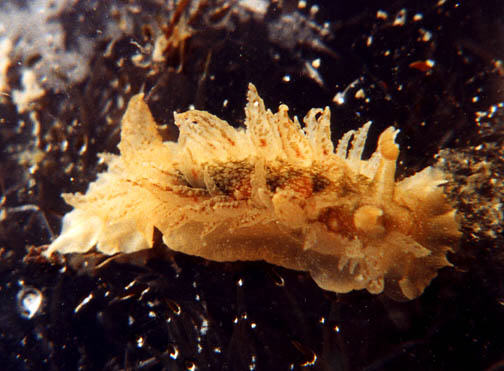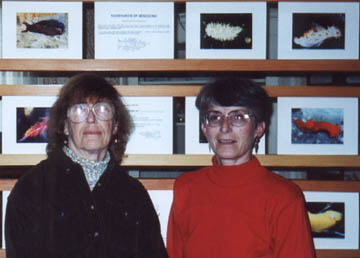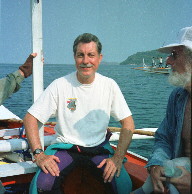 |
Dirona picta
Photo courtesy of Caroline Schooley and Mary Ellen Hill
Dirona picta Cockerell & Eliot, 1905
Dirona picta is a member of the Nudibranch suborder Arminacea. It is quite variable in color. PacificCoast Nudibranchs shows three distinct forms, which can vary from tan to orange, brown to green. Depending on the base color, the body and cerata are covered with white, yellow, olive green or even pink splotches. The species is highly cryptic on the arborescent hydroids it preys on. It has a broad frontal veil and the cerata are tuberulate.
It is interesting to note that while D. picta is very cryptic, the other two species of Dirona (D. albolineata and D. aurantia) on this coast are conspicuously colored.
As indicated by the authors names listed behind the name Dirona picta, this species is one of those few that has caused confusion in the literature because its original description was a subsection (written by Dr. Frank Mace MacFarland) in a large monograph authored by Drs. Cockerell & Elliot, back in 1905.
Dirona picta ranges from Cape Meares, in northern Oregon to Puerto Rompiente, Baja California Sur, Mexico. It is additionally reported from the northern Gulf of California and Japan.
The species reaches about 40 or so mm in length, and lays egg masses shaped as white bundled cords.
In a recent discussion on The Sea Slug Forum by Jeff Goddard, Bill
Rudman's raises a question about the nature of the interesting structure of
the cerata, and the possibility that the shape and color of the patches may
be the result of zooxanthellae, or some other symbiotic plant tissue.
Danville, Calif
July 2000

|
Tidepools are wet and slippery places, hazardous for both camera and photographer. It's easier to carry and protect small equipment, so almost all of Caroline's photos were taken with a 20-year-old "collector's camera", a Pentax Auto 110 SLR. It has a Pentax f2.8 20-40mm zoom lens, and a variety of front-of-the-lens closeup lenses have been added for macro work. Kodak Gold 200 ASA film was used 1995-7; most photos since then are with 400 ASA, which helps a lot in the lighting conditions of dawn and dusk low tides. This is all field photography; the only concession to "studio" technique is the frequent use of a clear plastic dish or a large shell to confine fast-moving subjects. All organisms were returned carefully and immediately to their original location. The photos taken under such conditions often have minor defects such as debris on the animal, glare or shadows, inaccurate color balance, or parts of the image out of focus. To improve this, all of these photos have been enhanced with digital processing; they were scanned at 300 dpi and corrected with Photoshop 5.
|
Taxonomic information courtesy of Dave Behrens

David W. Behrens
Author:
Pacific Coast Nudibranchs
Send Dave mail at seachalleng@earthlink.net
|
